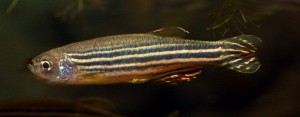
A recent clinical trial brings the drug FT1050 one step closer to becoming the first drug identified with the help of zebrafish (above) to make it to patients. (Soulkeeper/Wikimedia Commons)
In 2007, working with zebrafish, Leonard Zon and his team in Children’s Stem Cell Program made an unexpected discovery: That a drug originally developed to treat stomach ulcers could boost the production of blood stem cells, by about four-fold.
That drug – FT1050, a chemical variant of a fatty, hormone-like molecule called prostaglandin E2 (PGE2) – recently crossed a major milestone: the successful conclusion of a Phase I clinical trial. Led by Zon’s colleague Corey Cutler, a clinical researcher at Dana-Farber Cancer Institute, the trial aimed to determine the drug’s safety as a way of helping patients who receive umbilical cord blood stem cell transplants recover their immune function more quickly.
The trial brings the FT1050 one step closer to becoming the first drug identified with the help of zebrafish to make it to patients.
PGE2 came to Zon’s attention after screening 2,500 chemicals for ones that could help boost the numbers of cord blood stem cells available to patients needing stem cell transplants.
When a patient needing a blood (or hematopoietic) stem cell transplant can’t find a suitably matched donor, the only option is to use umbilical cord blood. While single cord rarely contains enough blood stem cells for older children and adults, using two cords increases the risk of immune complications. Cords are also expensive and in limited supply.
Cutler announced the first results of the FT1050 safety trial last month at a meeting of the American Society of Hematology. And the results look good. Twelve patients took part in this early stage trial, receiving umbilical cord blood stem cells that had been pre-treated with PGE2 to boost cell numbers. The transplanted cells took root in all 12 patients, doing so three to four days sooner compared to patients who received cells that weren’t pre-treated, with minimal side effects.
Encouraged by the findings, Cutler and his colleagues plan further studies of FT1050 in larger groups of patients.
“As a physician-scientist, it is a dream to translate your basic science into a new therapy for patients,” Zon says. “This is first time that a drug discovered using the zebrafish system has taken to a clinical trial.
“The demonstration that the drug is safe and probably efficacious is very satisfying.”







